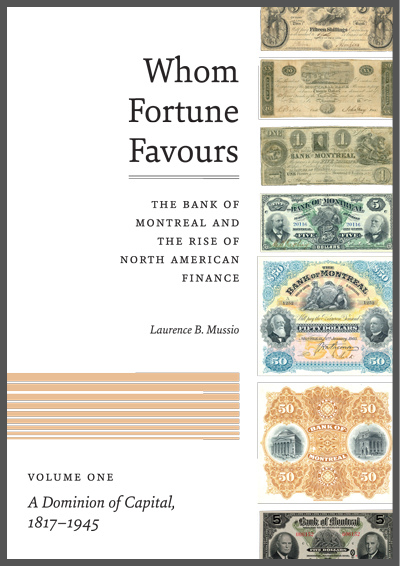
Erika Ayers Badan: Women in the Workplace Wake-Up Call
This headline somehow feels both shocking and completely unsurprising. The McKinsey and Lean In Women in the Workplace study is out, and the takeaway is…
Thought Leader: Erika Ayers Badan

“If it is worth pausing and reflecting on the magnitude of the transformations of our world, it is also necessary to insist on the continuities.” Laurence B. Mussio, Whom Fortune Favours
As we reach the end of an unusual and unprecedented month of April and consider all the necessary adjustments we have had to make along the way, a look back through Canada’s own economic history can provide some perspective and insight for the months to come.
In the face of the current COVID-19 pandemic, we asked MQUP author Laurence B. Mussio the question “What has the focus of your new book taught you about adapting and surviving change?” His response, shared below, illustrates the importance of adaptability and provides an inspiring example of a Canadian institution that has persevered, survived, and prospered through centuries of fundamental change.
In his two volume series Whom Fortune Favours: The Bank of Montreal and the Rise of North American Finance, Volume 1 & 2 historian Laurence Mussio applies an analytical lens to The Bank of Montreal (BMO), a financial institution whose strategies fundamentally shaped, and were shaped by, the evolution of a country and a continent. At its heart, Whom Fortune Favours presents a multifaceted story about the making of contemporary finance and a definitive history of Canada’s most enduring bank.
I have a confession to make. I first read the theme question too quickly. I thought MQUP was asking me to reflect on the process of producing this two-volume work and what that journey has taught me about adaptation and survival. Marathon projects like this do, in fact, try and test authors (and those with whom they work!). A typically solitary pursuit – researching and writing – becomes a much bigger and more complicated enterprise. The opportunities for learning about adaptation and survival are rich. Academic, corporate and publishing worlds are separate planets. Each may speak a common language, but the dialects and the cultures are very different. In fact, I am certain in the last many years, members of each sphere have quietly asked themselves, “What planet is/are he/they on?” But, as with so many imagined interplanetary encounters, I am convinced that this one has been a remarkably rich experience for author, subject and publisher. The project has not only generated books and scholarship, but also a spectrum of new ideas, connections and initiatives. I hope all of that will engender a greater appreciation for the importance of the long-run experience in navigating the grand challenges facing us today. Success is networked.
Now, to the real question at hand: what can Whom Fortune Favours, the new two-volume history of the Bank of Montreal, teach us about adapting and surviving change?
The entire history of Canada’s First Bank is an extended-play lesson in adapting to change, surviving it, and prospering. BMO is now North America’s eighth-largest financial institution. But that position was anything but preordained back in 1817. The last two centuries have embraced the rise and fall of empires, the emergence of nation-states, panics, bank failures, depressions, world wars, social upheaval, globalization, technological transformations, and revolutions in science, education, culture, style, fashion and thought. A lot can go wrong. Each generation of BMO bankers had to deal with a wide spectrum of circumstances of every sort.
BMO’s experience with adapting to change is important because of its sheer historical importance. It’s Canada’s first bank, its most historically influential bank, for a century or more the coordinator-in-chief of the Canadian chartered banks. It was a standard bearer for Canadian finance in the North Atlantic world. Its position changes in the 20th century as Canadian banking makes room for other players. As with any long-running institution, BMO has had encounters with every conceivable type of change – indeed, Volume II’s subtitle is Territories of Transformation. Responses and results varied, of course. But prospering over time also represents a premium for responding successfully to the dynamics of complexity, risk and uncertainty.

BMO CEO Matthew Barrett, 1996. Photo from Whom Fortune Favours, Source Bank of Montreal Archives.
There are many insights up and down the decades from the BMO experience that directly relate to adapting to change. The overall success story of the Bank over 200 years should not deter one from focusing in on the multiple episodes where each generation of leaders had choices to make and relationships to forge to ensure the institution was pushed and pulled forward. Each major chapter in BMO’s extraordinary history is a mini-case study in adaptation to change. In each era, in each of its twenty decades, BMO’s success revolved around its ability to both shape and to be shaped by changes in the ecosystems of finance and banking. That meant different things at different times. For most of the 19th century, a strategy of stability permeated bank leadership and culture. Survival and resilience were number one priorities for the Bank, not least because of its importance to Canadian finance and the country they sought to forge. In the 20th century and into the 21st, strategies had to be revamped as new competitive landscapes presented themselves. The stakes are higher in each successive generation, moreover.
The balance between form and dynamism – between the structures that endure and the need to renew the institution and creatively pull it forward – is at the heart of the Bank’s experience with adaptation. Each crisis and each opportunity demanded a rebalancing, for example, tipping the scales in favour of protecting the institution from harm, or expanding it when the opportunity arose. Tip the balance too much one way or the other, and the institution might become either too rigid, or too risk-prone. Here, the strategic role of leadership is vital, as is the ability to mobilize the culture of the institution to new conditions without losing its essential character.
For BMO and the Canadian financial system, success has also been networked. While it may depend mainly on the quality of its leadership and its ability to sustain a balance between form and dynamism, it also depends on the Canadian financial system’s public architecture. That architecture has been awfully good at handling systemic risk and configuring the banking system to withstand heavy shocks through effective regulation. In crisis times, this has made the banking system into a virtual national inheritance. In those times, even American observers have admired the resilience and sobriety of the Canadian system (though those voices are pin-drop silent in good times, when American banks produce eye-popping returns.) System architecture, collaborative relationships between bankers and government and leadership and culture are important elements in the success of Canadian banking.
I know this blog can only skim the surface of the question, but it does give you a basic idea of the insights the long run experience can provide to contemporary readers and leaders. I think it does so not by a recitation of the facts – the data itself – but rather the patterns that the data suggest over time. (I have written about this in relation to our current COVID-19 crisis here and here.) The greatest insights in adaptation and survival rely on pattern recognition from the long run – not just facts, and not “narratives,” but patterns. That may turn out to be the greatest contribution of Whom Fortune Favours to the current generation of decision makers. That contribution won’t come so much by asking “What did bankers do in the 1907/1918/1929 crisis?” but rather “How did that generation and its leadership deal with new and untried circumstances before them, what they got right and wrong, and what can we learn from all of it?” As Philip Tetlock recently observed, better explanations of how we got here can make for better predictions of where we are headed. That, perhaps is the point of understanding how primordial Canadian institutions like the Bank of Montreal has adapted to so much, over so long, to the benefit of so many.
Laurence B. Mussio is a senior business historian, consultant, and strategic advisor to senior executives in finance, technology and government. He is the co-founder of the Long Run Initiative. He lives in Toronto.
Erika Ayers Badan: Women in the Workplace Wake-Up Call
This headline somehow feels both shocking and completely unsurprising. The McKinsey and Lean In Women in the Workplace study is out, and the takeaway is…
Thought Leader: Erika Ayers Badan
Dr. Sanjay Gupta: Why Haven’t We Cured the Common Cold?
The average person gets two to four colds a year. With all the missed school and work, that adds up to an economic impact of…
Thought Leader: Sanjay Gupta
Niall Ferguson on the Logic Behind America’s New Worldview
Niall Ferguson argues that the media reaction to President Trump’s new National Security Strategy (NSS) says more about elite assumptions than about the document itself.…
Thought Leader: Niall Ferguson

